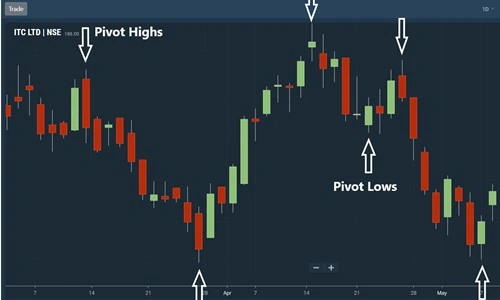Intraday trading, also known as day trading, involves buying and selling stocks, commodities, or financial instruments within the same trading day. Unlike long-term investing, where traders hold stocks for weeks, months, or years, intraday traders close all positions before the market closes to profit from short-term price movements.
In India, intraday trading is popular due to high market volatility, leverage options, and the potential for quick returns. It is actively practiced on the National Stock Exchange (NSE) and Bombay Stock Exchange (BSE), with traders using technical analysis, charts, and market trends to make decisions.
However, intraday trading is highly risky and requires skill, discipline, and experience. While it can generate quick profits, it can also lead to huge losses if not managed properly. In this article, we explore the advantages and disadvantages of intraday trading to help traders make an informed decision.
Quick Overview: Advantages & Disadvantages of Intraday Trading

| Advantages | Disadvantages |
|---|---|
| Quick Profit Potential | High Risk of Losses Due to Market Volatility |
| No Overnight Risk or Holding Costs | Requires High Market Knowledge & Expertise |
| Leverage Enhances Profitability | Can Lead to Emotional & Stressful Trading |
| Lower Capital Requirement Compared to Delivery Trading | High Brokerage & Transaction Costs |
| Opportunity to Profit in Bull & Bear Markets | Not Suitable for Beginners or Risk-Averse Investors |
| No Long-Term Investment Commitment | Time-Consuming & Requires Constant Monitoring |
Advantages of Intraday Trading
1. Quick Profit Potential
Intraday traders make profits within hours or minutes by taking advantage of short-term price fluctuations. Unlike long-term investors who wait for months or years, day traders can earn daily profits if they execute trades correctly.
For example, if a trader buys Tata Motors stock at ₹650 and sells it at ₹670 within the same day, they book a quick profit of ₹20 per share.
2. No Overnight Risk or Holding Costs
One major advantage of intraday trading is that all positions are closed before the market closes. This eliminates the risk of:
- Global market events affecting stock prices overnight
- Unexpected economic announcements impacting investments
- Gap-up or gap-down opening risks
Since traders don’t hold stocks overnight, they avoid carrying charges, interest costs, and exposure to unpredictable after-market events.
3. Leverage Enhances Profitability
Brokers provide margin trading for intraday traders, allowing them to trade with higher leverage. This means traders can buy stocks worth ₹5 lakh with just ₹1 lakh capital, amplifying their potential profits.
For example, if a stock moves 5% up and the trader used 5x leverage, their return would be 25% instead of 5%.
4. Lower Capital Requirement Compared to Delivery Trading
Since intraday trading involves leverage, traders don’t need huge capital to start. A small investment can control large volumes of stock, making it accessible to retail traders with limited funds.
For instance, with just ₹10,000 in margin, traders can buy stocks worth ₹50,000–₹1 lakh, depending on broker leverage policies.
5. Opportunity to Profit in Bull & Bear Markets
Unlike long-term investors who only benefit when stock prices rise, intraday traders can profit in both rising and falling markets through:
- Buying (going long) when prices are expected to rise
- Short-selling (going short) when prices are expected to fall
For example, if a trader anticipates that Reliance shares will drop, they can short-sell at ₹2,600 and buy back at ₹2,570, making a ₹30 profit per share.
6. No Long-Term Investment Commitment
Intraday trading does not require holding stocks for years or worrying about long-term market trends. Traders can:
- Avoid stock market crashes affecting portfolio value
- Stay liquid without tying up capital in long-term investments
- Quickly reinvest profits into new opportunities
This makes intraday trading ideal for those looking for short-term gains without committing capital for years.
Disadvantages of Intraday Trading
1. High Risk of Losses Due to Market Volatility
Intraday trading is highly volatile, and stock prices can move unexpectedly. If a trader misjudges a trade, they can face heavy losses within minutes.
For example, if a trader buys HDFC Bank shares at ₹1,650 expecting a rise, but news impacts the market, dropping the price to ₹1,600, they face a ₹50 per share loss instantly.
2. Requires High Market Knowledge & Expertise
Intraday trading is not suitable for beginners because it requires:
- Understanding of technical analysis & price charts
- Quick decision-making under pressure
- Knowledge of market trends & economic indicators
Traders who lack experience often make poor decisions, leading to heavy losses.
3. Can Lead to Emotional & Stressful Trading
Since intraday trading involves rapid price fluctuations, traders often experience panic, greed, and fear, leading to:
- Overtrading (placing too many trades)
- Holding losing trades for too long
- Exiting profitable trades too early due to fear
Without emotional discipline, traders can lose more than they gain.
4. High Brokerage & Transaction Costs
Since intraday traders buy and sell frequently, they incur multiple brokerage charges, transaction fees, and taxes, which can eat into profits.
For example, if a trader places 10 trades daily, brokerage fees can accumulate significantly, reducing net earnings.
5. Not Suitable for Beginners or Risk-Averse Investors
Intraday trading is not for everyone. It requires:
- Constant market monitoring
- Quick decision-making
- Ability to handle high losses
Beginners often struggle with market fluctuations, stop-loss strategies, and timing trades correctly, leading to losses.
6. Time-Consuming & Requires Constant Monitoring
Unlike long-term investing, where stocks can be held passively, intraday trading requires active monitoring. Traders need to:
- Analyze charts & trends daily
- React quickly to market movements
- Spend hours in front of the screen
For those with full-time jobs or limited screen time, intraday trading can be difficult to manage.
Who Should Consider Intraday Trading?
Best Suited For:
- Traders with strong technical analysis skills
- Those who can handle high-risk situations
- People with time to monitor markets daily
- Experienced investors looking for short-term profits
Not Suitable For:
- Beginners with no market experience
- Investors seeking stable, long-term wealth creation
- Individuals with low risk tolerance
- People who cannot dedicate time to screen monitoring
Tips for Successful Intraday Trading
- Use Stop-Loss Orders
- Always set a stop-loss to limit losses.
- Example: If buying a stock at ₹500, set a stop-loss at ₹490 to prevent major losses.
- Follow Market Trends
- Trade with the trend (bullish or bearish), not against it.
- Avoid Overtrading
- Don’t place excessive trades hoping to recover losses.
- Use Proper Risk Management
- Risk only 1-2% of capital per trade to minimize losses.
- Have a Clear Exit Strategy
- Book profits early; don’t wait for unrealistic price targets.
Conclusion: Is Intraday Trading Worth It?
Intraday trading offers quick profit opportunities but comes with high risks. For experienced traders with market knowledge, discipline, and risk management skills, it can be a profitable venture. However, for beginners or risk-averse investors, it may lead to significant losses.
Before starting intraday trading, learn technical analysis, set stop-losses, and manage emotions effectively. If done correctly, it can be a rewarding strategy, but traders must be cautious and disciplined.
Anantha Nageswaran is the chief editor and writer at TheBusinessBlaze.com. He specialises in business, finance, insurance, loan investment topics. With a strong background in business-finance and a passion for demystifying complex concepts, Anantha brings a unique perspective to his writing.


